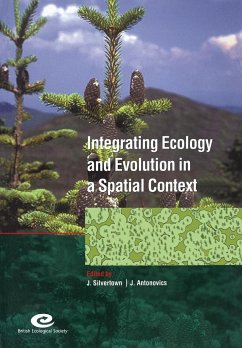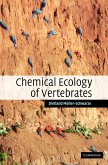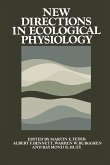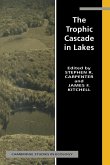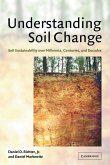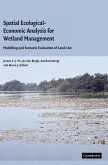Jonathan Silvertown / Janis Antonovics (eds.)
Integrat Ecol Evol Spatial Cont
Herausgeber: Silvertown, Jonathan; Antonovics, Janis
Jonathan Silvertown / Janis Antonovics (eds.)
Integrat Ecol Evol Spatial Cont
Herausgeber: Silvertown, Jonathan; Antonovics, Janis
- Broschiertes Buch
- Merkliste
- Auf die Merkliste
- Bewerten Bewerten
- Teilen
- Produkt teilen
- Produkterinnerung
- Produkterinnerung
This volume advances understanding of ecological and evolutionary processes in a common frame of reference--that of space. Relevant processes operating at the scale of the population, metapopulation, and the geographical range are accordingly examined. Although this study's focus is largely on plants, questions addressed are equally applicable to animals.
Andere Kunden interessierten sich auch für
![Chemical Ecology of Vertebrates Chemical Ecology of Vertebrates]() Dietland Muller-SchwarzeChemical Ecology of Vertebrates219,99 €
Dietland Muller-SchwarzeChemical Ecology of Vertebrates219,99 €![New Directions in Ecological Physiology New Directions in Ecological Physiology]() E. Feder / F. Bennett / Warren Burggren / W. Huey (eds.)New Directions in Ecological Physiology88,99 €
E. Feder / F. Bennett / Warren Burggren / W. Huey (eds.)New Directions in Ecological Physiology88,99 €![The Trophic Cascade in Lakes The Trophic Cascade in Lakes]() R. Carpenter / F. Kitchell (eds.)The Trophic Cascade in Lakes61,99 €
R. Carpenter / F. Kitchell (eds.)The Trophic Cascade in Lakes61,99 €![Fire and Vegetation Dynamics Fire and Vegetation Dynamics]() Edward A. JohnsonFire and Vegetation Dynamics47,99 €
Edward A. JohnsonFire and Vegetation Dynamics47,99 €![Estuaries of South Africa Estuaries of South Africa]() Estuaries of South Africa52,99 €
Estuaries of South Africa52,99 €![Understanding Soil Change Understanding Soil Change]() Daniel MarkewitzUnderstanding Soil Change62,99 €
Daniel MarkewitzUnderstanding Soil Change62,99 €![Spatial Ecological-Economic Analysis for Wetland Management Spatial Ecological-Economic Analysis for Wetland Management]() Jeroen C. J. M. BerghSpatial Ecological-Economic Analysis for Wetland Management140,99 €
Jeroen C. J. M. BerghSpatial Ecological-Economic Analysis for Wetland Management140,99 €-
-
-
This volume advances understanding of ecological and evolutionary processes in a common frame of reference--that of space. Relevant processes operating at the scale of the population, metapopulation, and the geographical range are accordingly examined. Although this study's focus is largely on plants, questions addressed are equally applicable to animals.
Hinweis: Dieser Artikel kann nur an eine deutsche Lieferadresse ausgeliefert werden.
Hinweis: Dieser Artikel kann nur an eine deutsche Lieferadresse ausgeliefert werden.
Produktdetails
- Produktdetails
- Verlag: Cambridge University Press
- Seitenzahl: 438
- Erscheinungstermin: 1. August 2001
- Englisch
- Abmessung: 244mm x 170mm x 23mm
- Gewicht: 751g
- ISBN-13: 9780521549332
- ISBN-10: 0521549337
- Artikelnr.: 22339848
- Herstellerkennzeichnung
- Libri GmbH
- Europaallee 1
- 36244 Bad Hersfeld
- gpsr@libri.de
- Verlag: Cambridge University Press
- Seitenzahl: 438
- Erscheinungstermin: 1. August 2001
- Englisch
- Abmessung: 244mm x 170mm x 23mm
- Gewicht: 751g
- ISBN-13: 9780521549332
- ISBN-10: 0521549337
- Artikelnr.: 22339848
- Herstellerkennzeichnung
- Libri GmbH
- Europaallee 1
- 36244 Bad Hersfeld
- gpsr@libri.de
Jonathan Silvertown is Professor of Ecology at the Open University.
Part I. Populations: 1. Plants stand still, but their genes don't:
non-trivial consequences of the obvious J. Silvertown; 2. Causes and
effects of small-scale spatial structure in plant populations R. Law, D. W.
Purves, D. J. Murrell and U. Diekmann; 3. Inferences about spatial
processes in plant populations from the analysis of molecular markers R. A.
Ennos; 4. Mating systems and population genetic structure in the light of
coalescent theory D. Charlesworth and J. R. Pannell; 5. Spatially explicit
studies on the ecology and genetics of population margins J. Antonovics, T.
J. Newman and B. J. Best; 6. The scale of local adaptation in forest plants
G. Bell, M. J. Lechowicz and M. Waterway; Part II. Metapopulations: 7.
Spatially realistic models of metapopulation dynamics and their
implications for ecological, genetic and evolutionary processes I. Hanski;
8. Landscape fragmentation and the viability of plant populations O.
Eriksson and J. Ehrlén; 9. The interaction of genetic and demographic
processes in plant metapopulations: a case study of Silene alba; D. E.
McCauley, C. M. Richards, S. N. Emery, R. A. Smith and J. W. McGlothlin;
10. The demography and genetics of host-pathogen interactions J. J. Burdon
and P. H. Thrall; 11. Spatial dynamics of cytoplasmic male sterility S. A.
Frank and C. M. Barr; 12. The evolution of seed heteromorphism in a
metapopulation: interactions between dispersal and dormancy I. Olivieri;
Part III. Geography: 13. Inferring glacial refugia and historical
migrations with molecular phylogenies G. M. Hewitt and K. M. Ibrahim;
14. From spatial patterns of genetic diversity to postglacial migration
processes in forest trees R. J. Petit, R. Bialozyt, S. Brewer, R. Cheddadi
and B. Comps; 15. Comparative phylogeography of northwestern North America:
a synthesis S. J. Brunsfeld, J. Sullivan, D. E. Soltis and P. S. Soltis;
16. A geographical context for the evolution of plant reproduction systems
S. C. H. Barrett, M. E. Dorken and A. L. Case; 17. Adaptation at the edge
of a species' range N. H. Barton; 18. The unified neutral theory of
biodiversity and biogeography: a synopsis of the theory and some challenges
ahead S. P. Hubbell.
non-trivial consequences of the obvious J. Silvertown; 2. Causes and
effects of small-scale spatial structure in plant populations R. Law, D. W.
Purves, D. J. Murrell and U. Diekmann; 3. Inferences about spatial
processes in plant populations from the analysis of molecular markers R. A.
Ennos; 4. Mating systems and population genetic structure in the light of
coalescent theory D. Charlesworth and J. R. Pannell; 5. Spatially explicit
studies on the ecology and genetics of population margins J. Antonovics, T.
J. Newman and B. J. Best; 6. The scale of local adaptation in forest plants
G. Bell, M. J. Lechowicz and M. Waterway; Part II. Metapopulations: 7.
Spatially realistic models of metapopulation dynamics and their
implications for ecological, genetic and evolutionary processes I. Hanski;
8. Landscape fragmentation and the viability of plant populations O.
Eriksson and J. Ehrlén; 9. The interaction of genetic and demographic
processes in plant metapopulations: a case study of Silene alba; D. E.
McCauley, C. M. Richards, S. N. Emery, R. A. Smith and J. W. McGlothlin;
10. The demography and genetics of host-pathogen interactions J. J. Burdon
and P. H. Thrall; 11. Spatial dynamics of cytoplasmic male sterility S. A.
Frank and C. M. Barr; 12. The evolution of seed heteromorphism in a
metapopulation: interactions between dispersal and dormancy I. Olivieri;
Part III. Geography: 13. Inferring glacial refugia and historical
migrations with molecular phylogenies G. M. Hewitt and K. M. Ibrahim;
14. From spatial patterns of genetic diversity to postglacial migration
processes in forest trees R. J. Petit, R. Bialozyt, S. Brewer, R. Cheddadi
and B. Comps; 15. Comparative phylogeography of northwestern North America:
a synthesis S. J. Brunsfeld, J. Sullivan, D. E. Soltis and P. S. Soltis;
16. A geographical context for the evolution of plant reproduction systems
S. C. H. Barrett, M. E. Dorken and A. L. Case; 17. Adaptation at the edge
of a species' range N. H. Barton; 18. The unified neutral theory of
biodiversity and biogeography: a synopsis of the theory and some challenges
ahead S. P. Hubbell.
Part I. Populations: 1. Plants stand still, but their genes don't:
non-trivial consequences of the obvious J. Silvertown; 2. Causes and
effects of small-scale spatial structure in plant populations R. Law, D. W.
Purves, D. J. Murrell and U. Diekmann; 3. Inferences about spatial
processes in plant populations from the analysis of molecular markers R. A.
Ennos; 4. Mating systems and population genetic structure in the light of
coalescent theory D. Charlesworth and J. R. Pannell; 5. Spatially explicit
studies on the ecology and genetics of population margins J. Antonovics, T.
J. Newman and B. J. Best; 6. The scale of local adaptation in forest plants
G. Bell, M. J. Lechowicz and M. Waterway; Part II. Metapopulations: 7.
Spatially realistic models of metapopulation dynamics and their
implications for ecological, genetic and evolutionary processes I. Hanski;
8. Landscape fragmentation and the viability of plant populations O.
Eriksson and J. Ehrlén; 9. The interaction of genetic and demographic
processes in plant metapopulations: a case study of Silene alba; D. E.
McCauley, C. M. Richards, S. N. Emery, R. A. Smith and J. W. McGlothlin;
10. The demography and genetics of host-pathogen interactions J. J. Burdon
and P. H. Thrall; 11. Spatial dynamics of cytoplasmic male sterility S. A.
Frank and C. M. Barr; 12. The evolution of seed heteromorphism in a
metapopulation: interactions between dispersal and dormancy I. Olivieri;
Part III. Geography: 13. Inferring glacial refugia and historical
migrations with molecular phylogenies G. M. Hewitt and K. M. Ibrahim;
14. From spatial patterns of genetic diversity to postglacial migration
processes in forest trees R. J. Petit, R. Bialozyt, S. Brewer, R. Cheddadi
and B. Comps; 15. Comparative phylogeography of northwestern North America:
a synthesis S. J. Brunsfeld, J. Sullivan, D. E. Soltis and P. S. Soltis;
16. A geographical context for the evolution of plant reproduction systems
S. C. H. Barrett, M. E. Dorken and A. L. Case; 17. Adaptation at the edge
of a species' range N. H. Barton; 18. The unified neutral theory of
biodiversity and biogeography: a synopsis of the theory and some challenges
ahead S. P. Hubbell.
non-trivial consequences of the obvious J. Silvertown; 2. Causes and
effects of small-scale spatial structure in plant populations R. Law, D. W.
Purves, D. J. Murrell and U. Diekmann; 3. Inferences about spatial
processes in plant populations from the analysis of molecular markers R. A.
Ennos; 4. Mating systems and population genetic structure in the light of
coalescent theory D. Charlesworth and J. R. Pannell; 5. Spatially explicit
studies on the ecology and genetics of population margins J. Antonovics, T.
J. Newman and B. J. Best; 6. The scale of local adaptation in forest plants
G. Bell, M. J. Lechowicz and M. Waterway; Part II. Metapopulations: 7.
Spatially realistic models of metapopulation dynamics and their
implications for ecological, genetic and evolutionary processes I. Hanski;
8. Landscape fragmentation and the viability of plant populations O.
Eriksson and J. Ehrlén; 9. The interaction of genetic and demographic
processes in plant metapopulations: a case study of Silene alba; D. E.
McCauley, C. M. Richards, S. N. Emery, R. A. Smith and J. W. McGlothlin;
10. The demography and genetics of host-pathogen interactions J. J. Burdon
and P. H. Thrall; 11. Spatial dynamics of cytoplasmic male sterility S. A.
Frank and C. M. Barr; 12. The evolution of seed heteromorphism in a
metapopulation: interactions between dispersal and dormancy I. Olivieri;
Part III. Geography: 13. Inferring glacial refugia and historical
migrations with molecular phylogenies G. M. Hewitt and K. M. Ibrahim;
14. From spatial patterns of genetic diversity to postglacial migration
processes in forest trees R. J. Petit, R. Bialozyt, S. Brewer, R. Cheddadi
and B. Comps; 15. Comparative phylogeography of northwestern North America:
a synthesis S. J. Brunsfeld, J. Sullivan, D. E. Soltis and P. S. Soltis;
16. A geographical context for the evolution of plant reproduction systems
S. C. H. Barrett, M. E. Dorken and A. L. Case; 17. Adaptation at the edge
of a species' range N. H. Barton; 18. The unified neutral theory of
biodiversity and biogeography: a synopsis of the theory and some challenges
ahead S. P. Hubbell.

